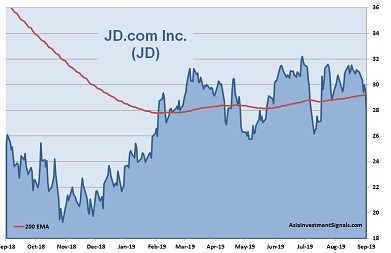 JD.com (JD) is China’s largest e-commerce and retail company by revenue. It is also the third-largest internet company in the world behind Amazon and Google. JD.com sells everything from food to household and luxury goods to millions of Chinese households.[mepr-active membership=”1734″ ifallowed=”show” unauth=”message” unauth_message=”Please login or purchase a membership to view full text.”]
JD.com (JD) is China’s largest e-commerce and retail company by revenue. It is also the third-largest internet company in the world behind Amazon and Google. JD.com sells everything from food to household and luxury goods to millions of Chinese households.[mepr-active membership=”1734″ ifallowed=”show” unauth=”message” unauth_message=”Please login or purchase a membership to view full text.”]
JD.com counts more than 321m active customers and is a constituent of the Fortune Global 500 and Forbes Global 2000 list. Compared to its main competitors, Amazon and Alibaba, JD.com has built its own nationwide fulfillment infrastructure and last-mile delivery network, that covers 99 percent of China’s population and operates with unrivaled speed and efficiency. JD.com has over 220,000 merchants on its online marketplace and operates some 600 automated warehouses, that can ship over 90 percent of the orders the same or next day.
JD.com has strategic cooperations with Tencent, Walmart, Vishop, Google, and announced several new partnerships with leading European fashion brands such as Prada and Giuseppe Zanotti to create unique experiences for shoppers. The company also invest heavily in the latest technologies such as AI, robotics, drones, autonomous vehicles to revolutionize the future of retailing.
JD.com operates two segments. The JD Retail (formerly known as JD Mall) segment contributed to about 96 percent to the total revenue and grew by 20 percent over the first six months of 2019 compared to the same period a year ago. The New Businesses segment, which includes third-party logistics services and the overseas business, contributes to 4 percent to the revenue and grew by 76 percent over the first half-year 2019.
JD.com was founded in 1998 and is headquartered in Beijing, China. The company is listed on US Nasdaq stock exchange since 2014. Its shares can also be traded in Germany, UK, Mexico, Austria, and Argentina. Major shareholder is Huang River Investment Limited with ownership of around 18 percent, followed by the chairman and CEO, Richard Qiangdong Liu, with an ownership of about 15 percent. Fifty-six percent of the shares are in public hand.
With a workforce of over 179 thousand employees, JD.com reported revenues of 39.5bn USD and profits before tax of 1.2bn USD over the first six months of 2019. This is an increase of 22 percent in revenue while income turned positive compared to the same period a year ago. In 2018, revenues increased by 28 percent, while income has been negative. The operating margin of less than one percent is still well behind industry average. JD.com’s cash reserves dropped by 4 percent to 4.8bn USD, while debts and lease obligations tripled to 1.5bn USD over the first half-year 2019.
The company shows an acceptable balance sheet with satisfactory profitability and financial strength. The equity ratio is at 35 percent and the gearing, defined here as total liabilities to total equity, at 179 percent. Moody’s daily credit risk score for JD.com is 5, indicating a medium risk, based on the day-to-day movements in market value compared to the company’s liability structure. Next earning results will be announced mid of November.
JD.com’s shares are in an uptrend since November 2018 and gained more than 40 percent in value since, 33 percent increase alone this year. The company is currently priced at 46 times earnings, four times book value, and at nine times operating cash flow. No dividends have been paid so far. 32 out of 37 analysts have a ‘strong buy’ or ‘buy’ recommendations on the stock.
Our conclusion: JD.com shows an acceptable balance sheet with satisfactory profitability and financial strength. The valuation is high but comes with a compounded annual growth rate for revenue and profits of more than 30 percent over the last three years. The outlook for online retailing in China is positive with expected growth rates of 20 percent annually for the next two years. JD.com expects its revenues to grow between 20 and 24 percent for this current quarter and plans to invest more heavily in growing in smaller Chinese cities. Analysts see earnings per share at 0.8 USD for next year, which translates into a forward p/e ratio of still 35.
The company is facing stiff competition from some significant players. Assuming a stable global economy, the share price has the potential to increase another 10 to 15 percent this year. Though, the risk of an already highly valued company should be kept in mind.
AIS Rating: ★★★☆☆
| 2014 | 2015 | 2016 | 2017 | 2018 | 2019 H1 only |
|
|---|---|---|---|---|---|---|
| EPS (RMB) | (5.4) | (3.3) | (1.4) | (0.1) | (0.9) | 2.7 |
| Change (%) | ||||||
| DPS (RMB) | n/a | n/a | n/a | n/a | n/a | n/a |
| P/E | P/E INDUSTRY |
P/B | P/CF | Equity Ratio* |
ROE | LIAB./ Equity** |
Div YLD |
|---|---|---|---|---|---|---|---|
| 46 | 17 | 4 | 9 | 35% | 10% | 179% | n/a |
* Equity / Total Assets, ** Total Liabilities / Equity
[/mepr-active]
